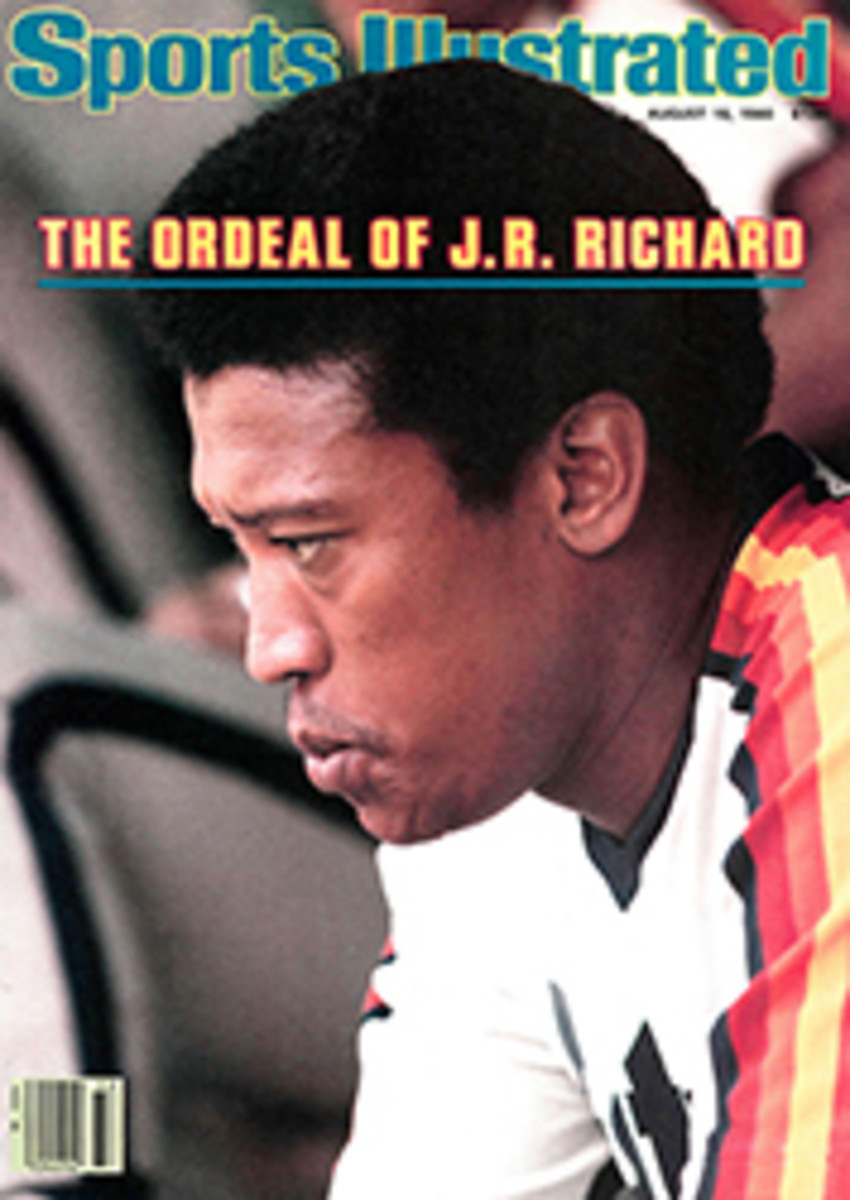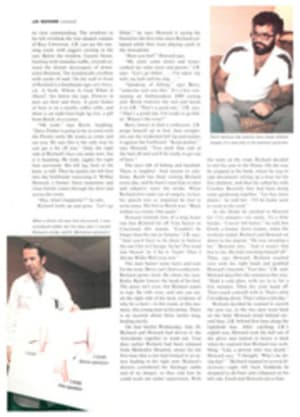
JACK, THIS IS GETTING RIDICULOUS
With that flying right elbow on his backswing and those small hands that force him to use the unorthodox interlocking grip and all of that time he takes standing over his putts, the chances are that Jack Nicklaus probably will never win 30 major championships. It has to catch up with him sooner or later, any golfing expert can see that.
Yeah, sure. Jack won his 19th major—six more than Bobby Jones or anyone else, ever—last week by turning the PGA Championship at the Oak Hill Country Club in Rochester, N.Y. into a hunting expedition in which you were supposed to find the rest of the field. But you could see that because of Nicklaus' age, which is 40, his desire and the mechanics of his game were deteriorating at the finish.
He made a bogey on the next-to-last hole and won his fifth PGA by only seven strokes, not eight. Oak Hill was definitely the beginning of the end because the course had been made tougher to prevent anyone from shooting an embarrassing 275, five under par, as Lee Trevino had back in 1968 when he won the U.S. Open. And on this tree-infested, rough-gnarled, water-patrolled layout, which had been carefully, even evilly, doctored, the best Jack could do was fire rounds of 70, 69, 66 and 69 for a total of 274.
Strangely, at the beginning of the week Nicklaus probably would have settled for a 274 for three rounds, not four. Like most golfers in their 40s, Nicklaus had lost his putting stroke somewhere, probably on the basketball court alongside his home at Lost Tree Village in Florida. He said he had used some 40 putts in one exhibition round with Tom Watson at Lake Tahoe, meaning he had suffered at least four three-putt greens—a year's supply in the good old days.
Nicklaus' putting was in such a sad state that he was even thinking of abandoning the old George Low flange-model putter that he had used in winning 17 of his 18 previous major championships. In 1967 Nicklaus won the U.S. Open at Baltusrol with his so-called White Fang putter, a center-shafted gold Bulls Eye that his wife, Barbara, kept dipping in white paint. But White Fang's luster wore off, and Nicklaus abandoned it after the '68 Open at Oak Hill. Two weeks ago, Nicklaus sent out to a number of golf shops for a handful of different putters and took many of them north; he tried one model, a Ping A-Blade similar to the putter preferred by Watson, for three straight practice rounds at Muirfield Village in his native Columbus, but that didn't seem to be the answer, either. Earlier he had even removed White Fang from the trophy case at Muirfield and put it in his bag—just in case he felt the urge. But back it went—unused.
Then, on Monday night, following Jack Nicklaus Day in Columbus, Nicklaus was on the putting green at Muirfield with his son, Jackie, a two-handicapper who starts college at North Carolina this fall. Jack couldn't hole anything, as usual, and was growing more exasperated by the minute. But Jackie came to the rescue, telling his father that his stance looked peculiar and that he was quitting on the stroke after impact and pulling his putter to the left.
Ah, thanks, son, and here's your allowance. Jack not only took Jackie's advice, he suddenly started to hole everything—and never stopped. In his four rounds at Oak Hill, Nicklaus, using his trusty Low flange, had only 117 putts, including just 27 on Friday and 28 on Saturday, and every time he "needed" a putt he made it.
And so the major championships keep piling up for this most remarkable of athletes. In case you've been marooned on an atoll for the last 20 years, Nicklaus now has won five Masters, four U.S. Opens, three British Opens and two U.S. Amateurs in addition to those five PGAs.
By adding this PGA to the U.S. Open he tore out of the New Jersey woods at Baltusrol in June, Jack became only the third man in history to take those two titles in the same year. Gene Sarazen did it in 1922 and Ben Hogan did it in 1948. Good company. Last week's victory in the city that produced Walter Hagen also marked the fifth time in his career that Jack claimed two majors in the same year, and it enabled him to tie Hagen in the category of Most PGA Championships Won. The world's largest bookshelf may be needed one of these days to store all the records that belong to Nicklaus.
The amusing thing about the 62nd PGA is that it came down to a contest between Nicklaus and the architects who had changed Oak Hill, and had done it much to the displeasure of just about every competitor in the field except Jack. These gentlemen were George Fazio, the old pro, and his nephew Tom.
When the golfers arrived and saw what the Fazios had done to the course, they started howling. They didn't like the new 5th and 6th holes, a narrow and brutal par-4 and a dangerous par-3, respectively. And they didn't like the new 15th, a demanding par-3, any more than the new 18th, which had become a more rugged par-4. They didn't like the way water hazards had been brought more directly into play, and they didn't like the shape of the greens, which were supposed to keep golf balls as far away from the pins as Toronto. And because Oak Hill was originally a Donald Ross course, and Ross is the Michelangelo of golf architects, the players yelped even louder.
Tom Weiskopf, a legendary howler, said, "I'm going to start an organization called the Classic Golf Course Preservation Society. Members get to carry loaded guns in case they see anybody touching a Donald Ross course."
Tom Watson, who solved Oak Hill only in the last round with a 67 that drew him into a tie for 10th place, said, "I don't think it's asking too much for a green to have a landing area where a good golf shot can get closer than 30 feet to the flag."
And Trevino, who had conquered the old Oak Hill and had his fond memories erased by the changes, said after finishing in seventh place at 285, "I just feel sorry for the members. They have to play Oak Hill all year long."
What happened was this: Oak Hill wanted to get itself back into the rotation for future U.S. Opens, and the USGA—recalling Trevino's record 275—had expressed the opinion that perhaps the course was no longer tough enough. So the Fazios were called in. Some of their doctoring was for increased difficulty and some was for better crowd control, or so said Tom Fazio. Oak Hill had the '80 PGA coming up, and had entered the bidding for the 1986 Open.
That being the case, one has to wonder whether Nicklaus' exploits have knocked Oak Hill out of any future majors. His 274 not only leveled the field, but it also represented a TKO over the Fazios, although Nicklaus did bogey their new 5th hole three times in the process of leaving Andy Bean, the runner-up, so many strokes in the distance he might as well have been Tom Fazio standing on the Oak Hill veranda.
But the answer to that question is: probably not. Oak Hill is still an unyielding golf course, one that only Jack Nicklaus could defeat. After all, no other player broke par of 280. And Nicklaus' scores were as much the result of his having a good week on the greens as they were of his shotmaking.
The only time Oak Hill really traded blows with Nicklaus was in Saturday's third round, although for 14 holes it appeared that he might shoot something like the astonishing 63 he had scored in the opening round at Baltusrol. He had made seven birdies and was six under par on the round and well on his way to taking the tournament away from the chaps who had led earlier, Craig Stadler after 18 and Gil Morgan after 36, not to forget his only serious pursuers, Bean and Lon Hinkle. "Jack was playing in a different world," Hinkle said.
But Saturday was the day Jack only played 14 holes. He three-putted the 15th, then briefly lost communication with his tee ball. A dive-bomb hook almost sent him out of bounds on the par-4 16th—his ball caromed off a fence and luckily stayed in play—and his second shot landed in a greenside trap, but he salvaged a par with a good putt. Another wild tee shot at 17 put him in position for an inescapable bogey. And still another poor tee shot on 18 might have meant another bogey, but his putter saved him again. Despite all this, Nicklaus shot a 66, the low round of the tournament.
Jack's lapse, however, enabled Hinkle, who birdied the 15th and 17th, to make up four strokes in the last four holes, and it left Nicklaus with only a three-shot lead over Hinkle going into Sunday.
Nicklaus went to the practice area Saturday evening and got straight with his swing. "Too short on the backswing," was his explanation for those hooks. And, indeed, there were none of those on Sunday when Nicklaus played and putted masterfully and quickly built his lead to five strokes after three holes, seven after 13 and eight after 14. He lost one stroke off his insurmountable lead while strolling through the last four holes, but his victory margin of seven shots was still another record.
"I guess it might have looked like a dull day to most people," Jack said, "but it wasn't dull to me. I played well, but you have to on this golf course. You have to play Oak Hill. If you wait for somebody to catch you, they will. I think that's a compliment to the course. It's a marvelous layout and it was in beautiful condition. I got lucky and managed to stay ahead of it."
Nicklaus added, "In judging how Oak Hill performed, I don't think anybody ought to look at what I did. They ought to look at what the rest of the field did."
If anyone could find the other players, they would, Jack.
PHOTO
JOHN D. HANLON
Following through on his stroke and keeping the blade dead on line, Nicklaus rarely missed a putt.

